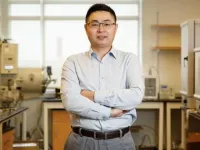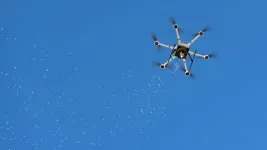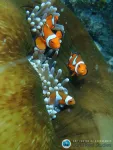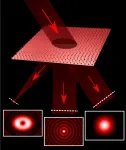Using the ancient art of Kirigami to make an eyeball-like camera
Curvy adaptable imaging sensor improves image, retains more pixels
2021-06-28
(Press-News.org) Cunjiang Yu, Bill D. Cook Associate Professor of Mechanical Engineering at the University of Houston, is reporting the development of a camera with a curvy, adaptable imaging sensor that could improve image quality in endoscopes, night-vision goggles, artificial compound eyes and fish-eye cameras.
"Existing curvy imagers are either flexible but not compatible with tunable focal surfaces, or stretchable but with low pixel density and pixel fill factors," reports Yu in Nature Electronics. "The new imager with kirigami design has a high pixel fill factor, before stretching, of 78% and can retain its optoelectronic performance while being biaxially stretched by 30%."
Modern digital camera systems using conventional rigid, flat imaging sensors require complex and bulky lenses to correct optical aberrations. The curvy camera, like a human eyeball, on the other hand, can work with a single lens while correcting aberrations and offering other merits, such as a wide field of view and compact size.
Yu has shown that the curvy and shape-adaptive cameras with high pixel fill factors can be created by transferring an array of ultrathin silicon pixels with a kirigami design onto curvy surfaces using conformal additive stamp (CAS) printing, a manufacturing technology invented in his lab.
Kirigami is the Japanese art of paper cutting, similar to origami, or paper folding. Yu used the kirigami principal on a thin sheet of imaging sensors, making cuts which allows it to stretch and curve. Compared to other stretchable structure designs, such as thin open-mesh serpentine or island-bridge structures, this new kirigami structure has a much higher fill factor, meaning it retains high pixel density, creating better images.
Not only is the camera curvy, but Yu makes it shape-adaptive, enabling it to capture objects at different distances clearly.
"The new adaptive imager can achieve focused views of objects at different distances by combining a concave-shaped camera printed on a magnetic rubber sheet with a tunable lens. Adaptive optical focus is achieved by tuning both the focal length of the lens and the curvature of the imager, allowing far and near objects to be imaged clearly with low aberration." said Yu, who is also a principal investigator of the Texas Center for Superconductivity at UH.
In CAS printing, an elastomeric, or stretchy, balloon with a sticky coating is inflated. It is then used as a stamping medium, pushing down on prefabricated electronic devices to pick up the electronics and print them onto various curvy surfaces.
INFORMATION:
In addition to Yu, researchers include first authors Zhoulyu Rao and Yuntao Lu, both with UH; Zhengwei Li and Jianliang Xiao, University of Colorado, Boulder; Zhenqiang Ma, University of Wisconsin-Madison; and Sim Kyoseung, former member of the Yu group and currently assistant professor at the Ulsan National Institute of Science and Technology in Ulsan, Korea.
[Attachments] See images for this press release:

ELSE PRESS RELEASES FROM THIS DATE:
2021-06-28
The world's human population is expanding, which means even more agricultural land will be needed to provide food for this growing population. However, choosing which areas to convert is difficult and depends on agricultural and environmental priorities, which can vary widely.
A study led by Princeton University illustrates this challenge by using several different approaches to solve the same puzzle: Given a target amount of food, where should new croplands be put to minimize environmental or biodiversity impacts?
The researchers used the country of Zambia as a case study given that it currently harbors a significant ...
2021-06-28
PHILADELPHA--Patients who had their wisdom teeth extracted had improved tasting abilities decades after having the surgery, a new Penn Medicine study published in the journal Chemical Senses found. The findings challenge the notion that removal of wisdom teeth, known as third molars, only has the potential for negative effects on taste, and represent one of the first studies to analyze the long-term effects of extraction on taste.
"Prior studies have only pointed to adverse effects on taste after extraction and it has been generally believed that those effects dissipate over time," said senior author Richard L. Doty, PhD, ...
2021-06-28
Annapolis, MD; June 28, 2021--Drones keep getting smaller and smaller, while their potential applications keep getting bigger and bigger. And now unmanned aircraft systems are taking on some of the world's biggest small problems: insect pests.
From crop-munching caterpillars to disease-transmitting mosquitoes, insects that threaten crops, ecosystems, and public health are increasingly being targeted with new pest-management strategies that deploy unmanned aircraft systems (UAS, or drones) for detection and control. And a variety of these applications are featured in a new special collection published this week in ...
2021-06-28
A new study has found baby coral reef fishes can outpace all other baby fishes in the ocean.
Lead author Adam Downie is a PhD candidate at the ARC Centre of Excellence for Coral Reef Studies at James Cook University (Coral CoE at JCU).
Mr Downie said when considering aquatic athletes, young coral reef fishes shine: they are some of the fastest babies, swimming around 15-40 body lengths per second.
As a comparison, herring babies swim up to two body lengths per second, and the fastest human in the water, Olympic gold medalist Michael Phelps, can only swim 1.4 body lengths ...
2021-06-28
The year 2020 was a period of economic hardship and significant change in a wide range of sectors for most countries. A team of authors from HSE University has explored how Russia will recover from this crisis and which industries will be affected by the economic recovery. Their study was published in the journal Voprosy ekonomiki.
Last year, the global economy experienced a crisis due to the coronavirus pandemic, with output falling by 3.5% compared to 2019. Russia's decline from the coronavirus measures was more moderate than in many developed countries (industrial ...
2021-06-28
Almost all of the nitrogen that fertilizes life in the open ocean of the Gulf of Mexico is carried into the gulf from shallower coastal areas, researchers from Florida State University found.
The work, published in Nature Communications, is crucial to understanding the food web of that ecosystem, which is a spawning ground for several commercially valuable species of fish, including the Atlantic bluefin tuna, which was a focus of the research.
"The open-ocean Gulf of Mexico is important for a lot of reasons," said Michael Stukel, an associate professor in the Department of Earth, ...
2021-06-28
LAWRENCE -- Despite facing cultural and political pushback, the evidence remains clear: Face masks made a difference in Kansas.
"These had a huge effect in counties that had a mask mandate," said Donna Ginther, the Roy A. Roberts Distinguished Professor of Economics and director of the Institute for Policy & Social Research at the University of Kansas. "Our research found that masks reduced cases, hospitalizations and deaths in counties that adopted them by around 60% across the board."
Ginther's article "Association of Mask Mandates and COVID-19 ...
2021-06-28
Washington, DC--Location, location, location--when it comes to the placement of wind turbines, the old real estate adage applies, according to new research published in Proceedings of the National Academy of Sciences by Carnegie's Enrico Antonini and Ken Caldeira.
Turbines convert the wind's kinetic energy into electrical energy as they turn. However, the very act of installing turbines affects our ability to harness the wind's power. As a turbine engages with the wind, it affects it. One turbine's extraction of energy from the wind influences the ability of its neighbors to do the same.
"Wind is never going to 'run dry' as an energy resource, but our ability to harvest it isn't infinitely scalable either," Antonini explained. "When wind turbines ...
2021-06-28
The ability to precisely control the various properties of laser light is critical to much of the technology that we use today, from commercial virtual reality (VR) headsets to microscopic imaging for biomedical research. Many of today's laser systems rely on separate, rotating components to control the wavelength, shape and power of a laser beam, making these devices bulky and difficult to maintain.
Now, researchers at the Harvard John A. Paulson School of Engineering and Applied Sciences have developed a single metasurface that can effectively tune the different properties of laser light, ...
2021-06-28
In the context of recent debate over the FDA's approval of aducanumab, it's refreshing to learn about a model of Alzheimer's neurodegeneration that doesn't start with the pathogenic proteins amyloid or Tau.
A new paper in Alzheimer's & Dementia from Emory neuroscientist Shan Ping Yu and colleagues focuses on an unusual member of the family of NMDA receptors, signaling molecules that are critical for learning and memory. Their findings contain leads for additional research on Alzheimer's, including drugs that are already FDA-approved that could be used preventively, and genes ...
LAST 30 PRESS RELEASES:
[Press-News.org] Using the ancient art of Kirigami to make an eyeball-like camera
Curvy adaptable imaging sensor improves image, retains more pixels






